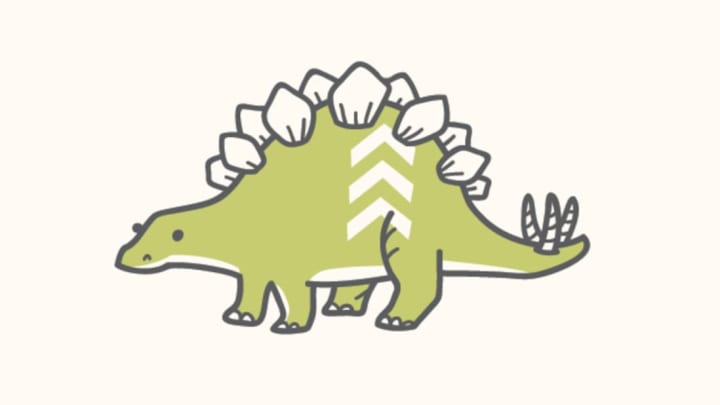Poor Stegosaurus. Thanks its relative brain size, the Jurassic herbivore—while popular—has been slapped with prehistoric punchlines for over a century. Today, we’re saluting one of earth’s most misunderstood dinosaurs.
1. Stegosaurus’ Name is a Giant Anachronism.
Meaning “roof lizard,” it references the outdated idea that Stegosaurus’ characteristic back plates were arranged horizontally like enormous shingles. We now know these weird-looking bones stood upright, though what they were actually used for remains an open question.
2. No, Stegosaurus Didn’t Have a Second Brain Above its Butt. That Myth Needs to Go Extinct.
To be fair, the spinal columns of certain dinos—such as Stegosaurus—do have sizable cavities around their fannies. During the late 1800s, some briefly speculated that a ‘posterior braincase’ was housed there; after all, since Stegosaurus’ cranium wasn’t exactly plus-sized, backup grey matter seemed like a helpful feature.
Amusing as that notion is, there isn’t a shred of decent evidence to support it (for instance, no modern animals have one). Sadly, however, this two-brained dinosaur rumor persists.
3. Stegosaurus Did, However, Boast Pebbly Throat Armor.
Circular lumps arranged on the neck’s underside would’ve assisted Stegosaurus in shielding its jugular from hungry predators.
4. It’s Also the State Fossil of Colorado.
Despite this, the Colorado Rockies’ current mascot is a purple Triceratops named "Dinger." At least with Stegosaurus, they could’ve thrown in some cheesy home "plate" puns. What a missed opportunity…
5. An Unlucky Allosaurus (Probably) Met the Business End of One.
Wanna hear something scary? A noticeable percentage of known Stegosaurus tail spikes have broken and re-healed tips, indicating that, in life, their owners put them to good use. Furthermore, one famous Allosaurus vertebrae includes an unusual hole which was apparently made when the carnivore tangled with a feisty Stegosaurus and its well-armed hind end.
6. Stegosaurus Would’ve Had an Interesting Gait.
Because its front legs were significantly shorter than the rear ones, Stegosaurus was hardly speedy or agile. Realizing this, the animators of 1999’s Walking with Dinosaurs series gave the creature a frontal swagger to accommodate this difference in limb length.
7. It Wasn’t Much of a Biter.
In 2010, using skull dimensions and tooth analyses, paleontologist Miriam Reichel found that Stegosaurus’ chompers didn’t exert much force, though being able to snip through “smaller branches” was still on their resume.
8. In 1920, Stegosaurus was Reimagined as a Dinosaurian Hang-Glider.
Beneath one of the freakiest dinosaur drawings ever conceived, journalist W.H. Ballou wrote that—by "flapping" its plates—Stegosaurus could “[coast] through the air like some gigantic gliding machine” in an article submitted to the Standard-Examiner of Ogden, Utah.
9. Stegosaurus May Have Inhabited Portugal.
Although it was first found in the U.S. (and is usually seen as a quintessentially American dino), fragmentary remains unearthed across the pond strongly imply that Stegosaurus also roamed Portuguese terrain 150 million years ago.
10. It Has an Odd Connection to Gary Larson’s The Far Side.
In one of The Far Side’s classic 1982 strips, a Neanderthal is seen pointing to a Stegosaurus tail, remarking “Now this end we call the thagomizer… after the late Thag Simmonds.” Since then, many paleontologists have been using the term "thagomizer" to denote real-life stegosaur tails.
“I think there should be cartoon confessionals,” Larson himself later opined, “where we could go and say things like, ‘Father, I have sinned—I have drawn dinosaurs and hominids together in the same cartoon.’”
